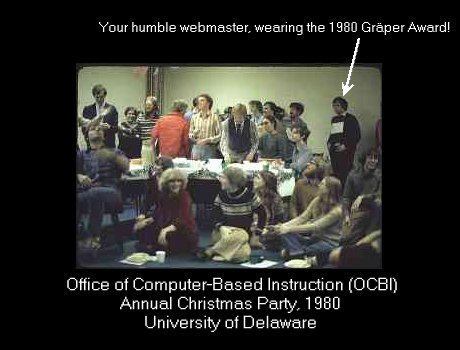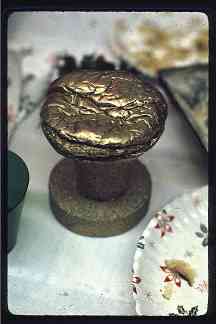of Dr. Gräper


Welcome to the complete archives of =grapenotes=, the crazy rantings of Dr. Gräper, the PLATO humorist. For the first time on the World Wide Web, the works of Dr. Gräper have been collected in one place for your reading pleasure.
If you're new to =grapenotes=, it might help to provide you with some answers to frequently asked questions:
Who is Dr. Gräper?
David J. Graper was an undergraduate student at the University of Delaware in
the late 1970's. He was a communications major, and became well-known on the
PLATO system for his various stories and humorous writings. Ironically,
David Graper went on to receive a Ph.D. degree from the University of Pennsylvania's
Annenberg School of Communications, so he became a genuine Dr.! As of 1998, he is
still at the Annenberg School, now director of the computer center.
What is PLATO?
PLATO was the name for a mainframe-based computer network that was developed to
deliver interactive multimedia programs to students at a number of universities,
government institutions, and corporate centers around the world in the 1970's and 80's.
The system was originally developed at the University of Illinois in 1960, and rapidly
evolved into one of the first, if not the first, online communities in the world, in the early
1970s. PLATO predates pretty much all of the "online community" features we've all come
to take for granted on the Internet, on the Web, and on online services like AOL --- it predates
all of that by twenty years. The webmaster of this site is writing a book
about the PLATO system and the community of creative people who built, used, and "lived and
breathed" it for years.
What is a "notesfile"?
"Notesfiles" were online message forums on the PLATO system. There were hundreds upon hundreds
of different notesfiles, each serving as a place where PLATO users could discuss a particular
subject. For more on the history of notesfiles, see Dave Woolley's essay on
PLATO conferencing.
What do the pair of equals signs around "=grapenotes=" signify?
It was a common practice on PLATO to add equals signs whenever you were referring to a
notesfile. Hence, =grapenotes=. Oftentimes only the first equals sign would be used,
as in =grapenotes. Originally the equals sign was used in a system utility program that
let site administrators see what each PLATO user was doing at the moment. If they were reading
a notesfile, an equals sign would appear to the left of the notesfile they were reading.
Other single-character symbols were used to identify other kinds of PLATO files, such as
instructional lessons.
What is a "Policy Note"?
Each PLATO notesfile had a "policy note" written by a notesfile "director" (the
administrator/moderator of the online forum). The Policy Note was provided so
readers would know what subject(s) the notesfile covered, what was appropriate and
inappropriate, and general rules and guidelines for using the notesfile. In the
case of =grapenotes=, Dr. Gräper's note, well, kinda lays it all on the line.
Why is the formatting weird within some of
the notes in the archives here?
The text comes straight from the PLATO system, and was saved in the early 1980's
by Dan Tripp. Unlike current personal computers which use 8-bit ASCII characters,
PLATO was not ASCII and was based on a 6-bit character. In a nutshell, this meant
that for capital letters and many other characters, PLATO needed 2 bytes just to
represent the character. For example 'G' would have been represented by 2 bytes,
the first of which was a nonprintable character that the system knew to mean
"shift" and the second character which would have been 'g'. What a PLATO user
would have seen, on a PLATO terminal, would have been a capital 'G'.
Despite the fairly accurate conversion that went on to save the =grapenotes= archives from the PLATO system into an early personal computer in the 1980's, some characters didn't do so well. For example, you'll notice that the umlaut over the 'a' in Gräper didn't get translated too well in the archives. In many cases, I've just fixed it to "Graper" and removed the umlaut.
In another example, to underline a character or word in PLATO was quite a task for the system: you would have to press SHIFT-spacebar and then SHIFT-'-' to move the cursor backwards one character and then "overlay" an underscore character. If you wanted to underline a whole word (see the Policy Note for an example of what an underlined word looked like on a PLATO terminal) you had to press SHIFT-spacebar n times (where n was the number of characters in the word or phrase you wanted to underline) and then SHIFT-'-' n times (for the underscores). Well, as you'll no doubt see, in the archives of this website, any underlined text shows up as
underlined text_______________
instead of as
underlined text.
While reading the notes in the archive,
I keep coming across these "Responses", as in "Response 5 of 9". What are "responses"?
PLATO notes could only be about 30 lines long. Since the text of most of Dr. Gräper's stories
extended much further than 30 lines, the text was broken up into one or more "responses" to the
"base note" (starting note). Also, any other =grapenotes= reader of the time, who wanted to
respond or comment to something they'd read could write a response which would show up as a new
"response" to the message.
Who owns and maintains this website?
Brian Dear, that's me, your humble webmaster. I attended the University of
Delaware in the late 1970's and early 80's, and that is where I discovered the PLATO
system and, eventually, =grapenotes=. Inspired by =grapenotes=, I launched a satirical
notesfile called =denounce= in 1980, which went on to win the coveted GRAPER HUMOR AWARD in
1980. (See the photos below.) "Denounce" was revived in 1996 as a
satire site on the World Wide Web, and has gone on to
receive worldwide recognition and awards from establishments ranging from the well-known and
familiar to and the unknown and obscure.

 |
The "trophy" I was given in 1980 as the winner of the Graper humor award. Note that it is a Cheeseburger mounted on a styrofoam pedestal, and then the whole thing SPRAY-PAINTED GOLD! Needless to say, this was one trophy I could not keep for more than a few hours! |
For more info, or if you have comments, please email the webmaster (Brian Dear) at brian@grapenotes.com.
Last updated 20 May 2002
another Birdrock Ventures production